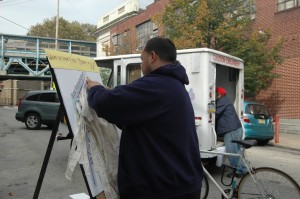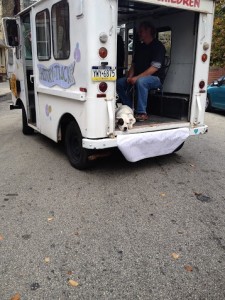The History Truck
 Do you know about the Philadelphia History Truck?
Do you know about the Philadelphia History Truck?
In April, I had the opportunity to meet Erin Bernard, the creator, curator, and public historian of the Philadelphia History Truck at the National Council on Public History Conference in Nashville.
Like a food truck, the History Truck brings history to the people. Erin strives to tell the story of Philadelphia one neighborhood at a time. Her goal is to connect Philadelphians to their history and allow them to participate in the processes of museum work.
In this post, you will discover how the History Truck works and how you can support its efforts.
How the History Truck Works
Erin, her team, and truck operate in a 10-step cycle:
1. Partner with a neighborhood association
2. Build community relationships by participating in neighborhood activities
3. Facilitate 1:1 oral history interviews & host a storytelling block party featuring neighborhood memories and objects
4. History Truck staff conduct research to verify and contextualize oral histories about the community
5. Use the truck to transport and display an historically-based art exhibit in community green spaces
6. Hold meetings with community members to design a new exhibit about their community
7. Display the exhibit in a neighborhood space to help activate the cultural energy within the neighborhood and empower community members to see and use their neighborhood as a museum and art space
8. Host an exhibit opening that celebrates the artists within the community who helped to make the exhibit
9. Downsize the exhibit and use the truck to transport it across Philadelphia for display in other neighborhoods as a means of connecting neighborhoods with the community message
10. Select a new neighborhood. Start the cycle again
Tonight, June 19, 2015, the Philadelphia History Truck will host its second-annual community exhibit: They Say They Gonna Build, an exhibit that explores university expansion and community building in North Philadelphia.
Conclusion
Erin has proven that the History Truck model works.
She has enabled residents in two Philadelphia neighborhoods to connect with their past and participate in conveying their history to their fellow Philadelphians. However, like digital history projects, the work of the History Truck requires time, manpower, and funding to keep going.
In fact, the Philadelphia History Truck project needs a new truck!
For the past two years, Erin and her team have borrowed a truck while they demonstrated that the "History Truck" model of community-based history works. Now the project needs a new truck that will provide it with a permanent home.
Please consider supporting this endeavor. You can find more information about the History Truck and its Indiegogo campaign by clicking on the appropriate links.

